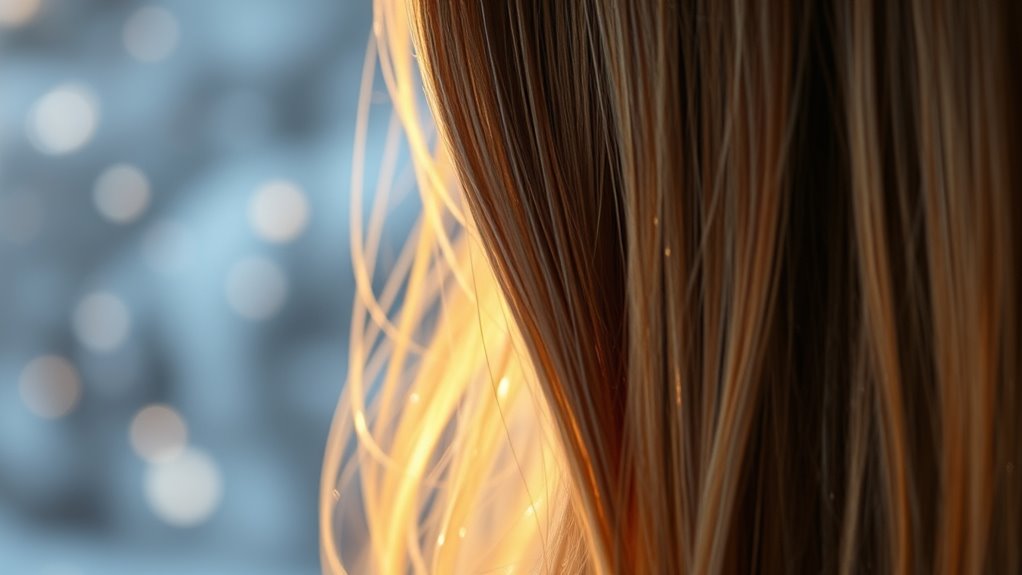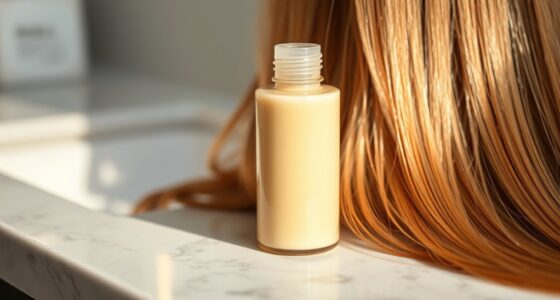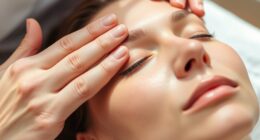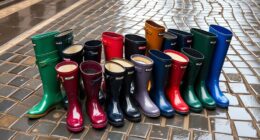To beat static hair and frizz this winter, start by using hydrating shampoos and applying leave-in conditioner for moisture. Limit heat styling to prevent damage and consider using an ionic hair dryer to reduce static. Incorporate anti-static sprays or dryer sheets for quick fixes. Don’t forget to add moisture to your environment with a humidifier, and choose natural fiber hats to minimize friction. There’s more to discover about keeping your hair smooth and manageable this season.
Key Takeaways
- Use hydrating shampoos and deep conditioners to restore moisture and combat dryness that leads to static hair.
- Incorporate leave-in conditioners and hair oils, like argan oil, for all-day hydration and smoothness.
- Limit heat styling and opt for an ionic hair dryer to reduce static buildup during styling.
- Use anti-static sprays or dryer sheets on brushes to manage static and frizz effectively.
- Utilize a humidifier indoors to add moisture to the air and minimize environmental dryness.

Static hair can be a frustrating problem, especially during the dry winter months when humidity plummets. You might find your hair standing on end or feeling like a frizzy mess. This happens primarily due to dry air, which robs your hair of moisture. When the air is stripped of humidity, your hair loses its natural balance, making it more prone to static buildup. Additionally, friction from hats or brushes can further exacerbate the issue by transferring electrons and creating that annoying static electricity.
Static hair can be especially bothersome in winter, as dry air and friction lead to frizz and annoying flyaways.
To combat static hair, you should start with your hair care routine. Using hydrating shampoos is essential, as they help restore moisture to dry strands. Follow up with a leave-in conditioner to maintain hydration throughout the day. You could also take into account weekly deep conditioning treatments to lock in moisture and reduce frizz effectively. Incorporating hair oils like argan oil into your routine can work wonders, keeping your hair hydrated and smooth while minimizing static. Additionally, drinking herbal teas like chamomile may promote relaxation, which can help minimize stress-induced static buildup. Regular use of hydrating serums can also enhance moisture retention and prevent static. Furthermore, ensuring your diet is rich in essential fatty acids can support overall hair health, which may help reduce static issues.
When it comes to styling, gentle techniques make a significant difference. Try to limit heat styling, as excessive heat can damage hair and increase static buildup. If you do need to dry your hair, think about using an ionic hair dryer, which emits negative ions to neutralize any positive charges causing static.
Opt for natural fiber brushes instead of synthetic ones, as they minimize friction and help keep your hair calmer. A cold water rinse at the end of your shower can also help retain your hair’s natural oils and moisture.
You might want to explore static-reducing products as well. Anti-static sprays, like Frizz Dismiss, can help manage both static and frizz. A quick fix is to spray hairspray on your brush before styling, as it attracts static to the metal. For an even easier solution, you could use dryer sheets to temporarily reduce static in your hair.
Another factor to reflect on is your choice of hats. Try wearing hats made from natural fibers like silk or cotton, which can reduce friction and static. Avoid hats with synthetic linings that contribute to the problem. If you find yourself wearing hats often, switching them up or reducing wear can help minimize static buildup.
Lastly, environmental adjustments can also play an important role. Using a humidifier adds moisture to the air, combating dryness. Maintaining cooler indoor temperatures can help retain that moisture, protecting your hair from the harsh winter effects. Additionally, consider incorporating a moisture-retaining routine to keep your hair healthy and static-free throughout the winter months.
Frequently Asked Questions
What Causes Static Hair in Winter Months?
In winter, static hair results from a combination of dry air, increased friction, and lack of moisture.
As the humidity drops, your hair loses its natural hydration, making it brittle and prone to static.
When you wear synthetic fabrics, like hats and scarves, or brush your hair, friction builds up, causing strands to repel each other.
This accumulation of electrical charge leads to the annoying static you experience during these cold months.
Can Certain Hairstyles Help Reduce Static?
You might think that hairstyles can’t do much to combat static, but you’d be surprised! Certain styles can definitely help reduce static in your hair.
Tight buns and braids keep strands together, minimizing movement and friction. Pinned back styles and low ponytails prevent hair ends from rubbing against clothing, while updos with volume keep your hair from lying flat.
Are There Specific Products to Avoid for Static Hair?
When it comes to managing static hair, you’ll want to avoid certain products.
Steer clear of shampoos with alcohol, sulfates, and drying ingredients, as they strip your hair of moisture. Aerosol dry shampoos often contain alcohol, which can worsen dryness. Gels and foams are typically drying too.
Instead, focus on hydrating products that nourish your hair and keep it manageable, helping to minimize static and frizz throughout the day.
How Often Should I Wash My Hair in Winter?
In winter, you should wash your hair about once or twice a week, depending on your hair type.
If you’ve got thick, coarse, or curly hair, sticking to this frequency helps maintain moisture. Reducing washing can prevent dryness caused by cold air.
If your scalp gets oily or you have specific conditions like dandruff, you might need to wash more often, around three to four times a week.
Always listen to your hair’s needs!
Is Static Hair a Sign of Damaged Hair?
Static hair can indicate damaged hair, but not always. If you notice excessive static, it might mean your hair’s moisture levels are low, leading to dryness and increased friction.
Fine hair types often experience more static due to their lightweight nature. To determine if your hair is truly damaged, check for split ends, breakage, or lack of shine.
Addressing these issues can help restore your hair’s health and reduce static effectively.
Conclusion
In the battle against winter frizz, you’re not alone; nearly 80% of women experience static hair during the colder months. But don’t let that number get you down! With the right tips and tricks, you can easily conquer those pesky flyaways. Remember to embrace moisture, use the right products, and keep your hair healthy. By taking these steps, you’ll not only beat the frizz but also feel confident and fabulous all winter long!










